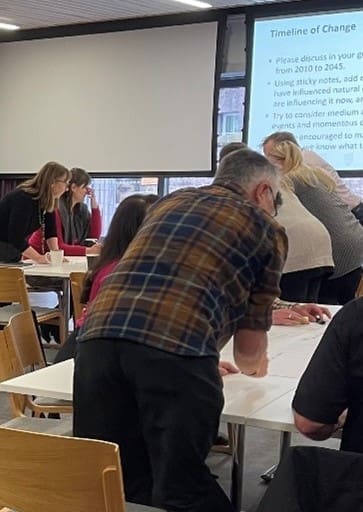When the value of nature is discussed, a lot of attention is given to its economic aspects. The current trend of considering nature as ‘natural capital’, therefore, perhaps lends itself to an economic way of thinking. But what if we considered a more diverse range of values associated with nature? Could this provide a truer and more inclusive picture of nature’s value, and could this encourage fairer and more sustainable management of people’s relationships with it?
Aiming to explore this, in January 2024, my colleagues and I from the James Hutton Institute hosted a workshop about natural capital with ClimateXChange. This was conducted as part of two projects on natural capital: ‘Bringing in participatory approaches to widen the scope of natural capital valuation’, and ‘Climate change impacts on natural capital’, which are funded by the Scottish Government’s Strategic Research Programme. This workshop also followed on from an online expert consultation on values for natural capital, held in May 2023. Our aim was to explore the range of values for natural capital in Scotland, beyond just the economic aspects, as well as what could affect changes in these values in the future.
Methodology
We invited representatives from the Scottish Government, who work in the research-for-policy interface, from community development organisations, from environmental organisations, from agriculture and land management, and from forestry organisations, as well as academic researchers, to join the conversation.
We used a ‘scenario planning’ approach to explore values for natural capital and how these could change in the future. Scenario planning involves imagining and analysing a set of scenarios that describe plausible future conditions of a particular subject (in this case natural capital in Scotland), through discussion in groups. As part of this, we split participants into three discussion groups and first asked them to reflect on what has influenced the development of natural capital, values for nature and natural capital management since 2010, and think about what might plausibly influence this in the future, up to 2045 – the Scottish Government’s target for meeting net zero.
We then asked participants to consider in more depth the drivers of change – the kinds of trends, patterns and events that could influence changes in natural capital, values for nature and natural capital management. We asked them to consider drivers of change across the categories of social, technological, environmental, economic and policy aspects.

Finally, we asked participants to select social, technological, environmental, economic and policy drivers and make assumptions about how they could develop in the future. We asked participants to reflect on whether those drivers are likely to bring positive or negative change, or if they might maintain business as usual.
Community values and natural capital
The discussion in all of the groups, but especially in my group, had a strong focus on community values associated with connectedness with place. This idea was built on an assumption that people’s connection with place is inherently tied up with the nonhuman landscape and ecosystem around them.
In a positive scenario, people who are more connected to nature and the rural landscape would be empowered through local governance and stronger local economies. Interestingly, there was an assumption that if people are more connected to nature in their local landscapes, they would manage it in a more caring manner and improve the condition of natural capital.
Participants thus perceived a cyclic relationship between community values and the condition of nature. Participants assumed that stronger community values associated with local communities’ connectedness with local place would lead to more compassionate relationships with nature in those places, including greater emphasis on its intrinsic value. They assumed people’s compassionate relationships and subsequent desire to keep ecosystems healthy would increase the resilience and condition of the ecosystem around them, which would in turn enhance people’s interactions and relationships with nature.
Natural capital valuation
Although there are other perspectives out there, I think the fact that values associated with community, connectedness to place and people’s relationships with local landscapes, came up so strongly in this conversation, emphasises the importance of other-than-economic values receiving more attention in natural capital valuation.
A learning point for me was the importance of considering people and their connections with nature as interwoven with natural capital, rather than taking an anthropocentric view of humans as separate from nature.
This learning will inform future aspects of the work on both of these projects, especially the development and application of participatory valuation approaches in a case study as part of ‘Bringing in participatory approaches to widen the scope of natural capital valuation’, and also assessment of how future risks and opportunities could affect the diverse values of natural capital in ‘Climate change impacts on natural capital’.
Related links
Bringing in participatory approaches to widen the scope of natural capital valuation